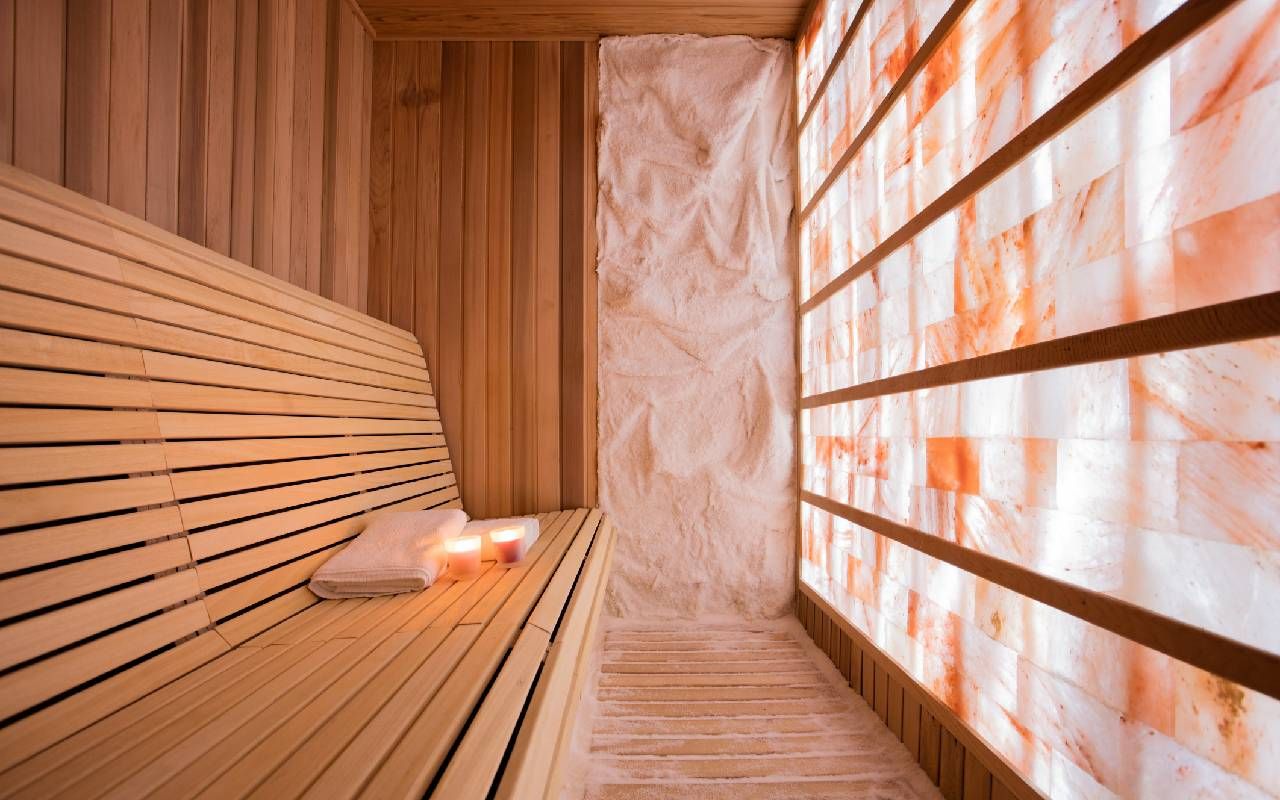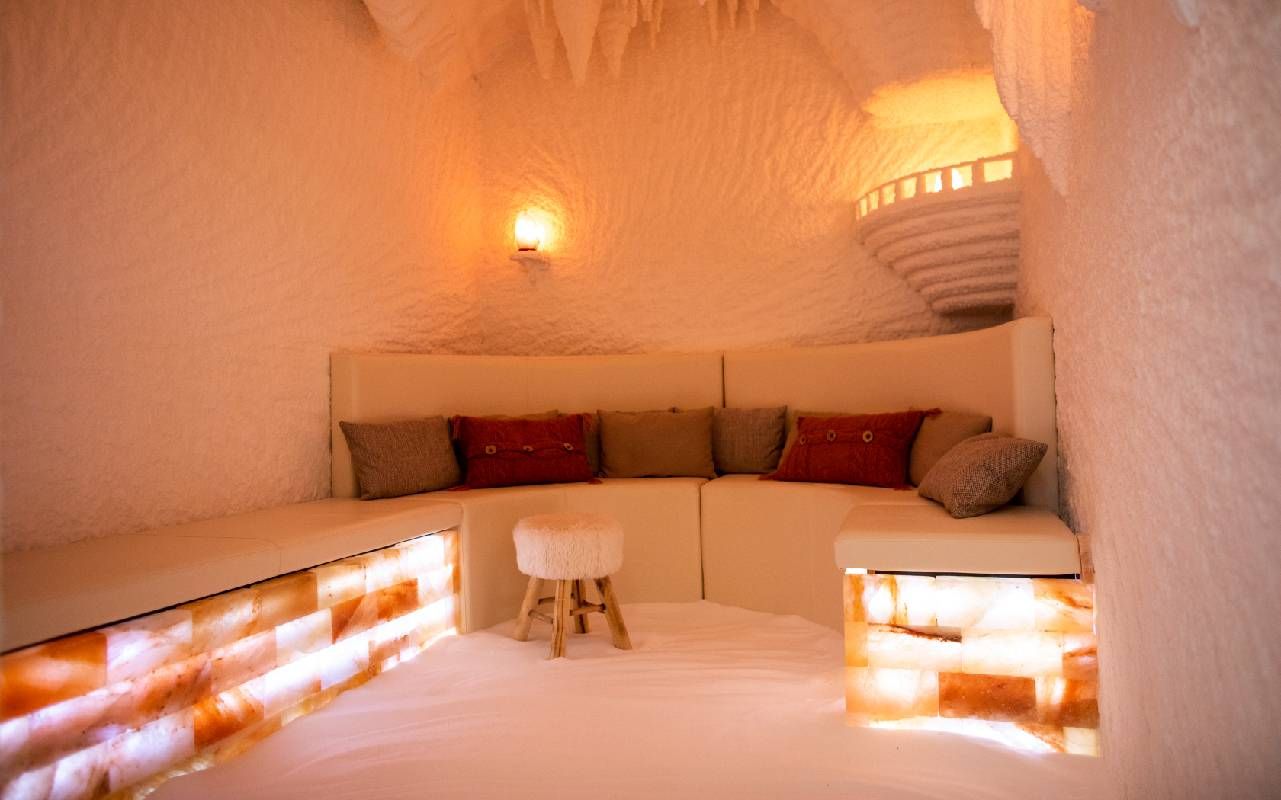Welcome to the World of Salt Therapy
Salt therapies are holistic wellness treatments aimed at promoting relaxation as well as enhancing respiratory health, including improvement in allergic and respiratory conditions
Because it's still cold and flu season here in the Big Apple, along with my usual stay-healthy routine of Vitamin C, probiotics and plenty of sleep, I've been doing something that is new to me, although it's far from new.
I've been going to a salt room to partake in something called halotherapy. It's been a relaxing and delightful experience, and even if you're lucky enough to live somewhere where winter doesn't exist, you might want to think about giving it a whirl.

The History of Halotherapy
Salt therapy (halotherapy) originated in the salt mines and caves in Poland in the 1800s, when it was originally called speleotherapy. It was noted that the miners, who chiseled, ground and hammered the salt and naturally inhaled the particles, had fewer respiratory illnesses and enjoyed robust health in spite of the harsh working conditions.
In various forms, salt has been used for medicinal purposes for thousands of years, dating back to antiquity.
Somewhere in the late 1970s or early 1980s, Russian scientists developed the first halotherapy device, called a halogenerator, which pulverized 100% pure sodium chloride into tiny microparticles, mimicking the grinding and crushing of salt done by the miners. Individuals undergoing the treatment spent time in rooms or chambers where the aerosolized dry salt was breathed in and also absorbed through the skin, making this the first above-ground halotherapy treatment.
In various forms, salt has been used for medicinal purposes for thousands of years, dating back to antiquity. According to the Salt Therapy Association, salt has anti-inflammatory and antimicrobial properties and effectively stops the growth of bacteria, yeast, mold and other disease-causing organisms. It also has mucolytic properties, meaning that it thins mucus, making it easier to expectorate.
Salt therapies are often used for symptom improvement in allergic and respiratory conditions. Sodium chloride is used in nebulizers to administer medication to the lungs in the form of an inhaled mist. Over-the-counter salt therapies include nasal sprays, pumps and rinses. Neti pots, originally used in the Ayurvedic tradition, utilize saline rinses to soothe dry, irritated nasal passages and to help in ridding the nose and upper airways of mucus and irritants.
How Halotherapy Works
Salt caves or rooms deliver a dry salt therapy experience in an environment filled with microscopic pharmaceutical-grade sodium chloride particles that are ground and dispersed by a halogenerator. The dry salt aerosol is pumped into the treatment space, which has walls, ceiling and floors covered with layers of salt and Himalayan salt bricks. A typical salt room can contain as many as 15,000 pounds of salt crystals. Breathing in and absorbing the aerosolized particles helps to break down mucus in the airways, and is a non-invasive and effective way to maintain clearer air passages.

Many traditionally trained doctors in the U.S. are skeptical that halotherapy confers any real benefits, although most agree that the treatment does not present any health dangers. There are some contraindications due to certain underlying medical conditions, such as severe hypertension, lung cancer, active tuberculosis and the presence of open wounds. You should always check with your health care provider before visiting a salt room.
Functional medicine physicians, practitioners of alternative and complementary medicine and naturopathic doctors here and abroad believe that halotherapy helps to relieve symptoms present in bronchitis, sinusitis, asthma, smokers' cough, upper respiratory tract infections and chronic obstructive pulmonary disease. (COPD). It does this by eliminating allergens in the respiratory tract, thinning mucus, reducing inflammation and cleansing and detoxing the lungs.
Some doctors believe it can reduce the need for decongestants. Halotherapy also has been found to relieve skin irritations such as eczema, psoriasis and rashes by impacting the skin microcirculation and inducing repair and regeneration.
Salt rooms are found in a variety of venues – medical spas, wellness centers, destination resorts, yoga studios, chiropractor and acupuncturists' offices. According to the Salt Therapy Association, there are more than 2,000 facilities in the United States and Canada offering the treatment.
What to Expect
Because these are holistic wellness treatments aimed at promoting relaxation as well as enhancing respiratory health, salt rooms are usually attractively outfitted with zero gravity chairs or loungers and pretty pink-hued Himalayan salt rock lamps. These generate small amounts of negative ions in the atmosphere which are supposedly correlated with a variety of positive effects on health and wellness. Room temperature is usually a comfortable 70 to 72 degrees, and soft, meditative music is often playing in the background. Depending on the size of the room, which is always kept well ventilated, as many as six to eight people can receive the treatment at the same time.
Room temperature is usually a comfortable 70 to 72 degrees, and soft, meditative music is often playing in the background.
Sessions are generally 45 minutes and the number of sessions recommended range from five to as many as twenty, depending on the severity and chronicity of symptoms. Some people with respiratory conditions such as asthma go once or twice a month for continued maintenance of benefits. Sessions are priced anywhere from $20 to $70 a session depending on location.
What the Science Shows
Numerous scientific studies done in Russia, Finland, Italy and Eastern Europe tout the benefits of salt room therapy. Many fewer studies have been done in the United States.
A 2022 article in Alternative Therapy Health Medicine, which reviewed existing English-language literature about halotherapy from January 1980 to December 2018 found that clinical trials have confirmed salt therapy is an effective option for relieving symptoms in a variety of acute and chronic respiratory conditions, with users "overwhelmingly showing improvement in pulmonary function measures."
"Many of our patients have attributed salt therapy to breaking the cycle of being in and out of the hospital that plagued them for years due to breathing exacerbations or pneumonia."
A recent article in the Journal of Clinical and Experimental Investigations suggests that halotherapy has an important place in alternative medicine, including for individuals who have chronic respiratory conditions as a result of COVID-19. In August of 2021, researchers at the Harvard John A. Paulson School of Engineering and Applied Sciences, Massachusetts General Hospital and the National Institutes of Health released two studies showing that breathing humid and salt-enriched air promoted upper airway cleansing and lessened the generation of respiratory droplets, potentially reducing COVID-19 incidence, transmission and symptoms.
Tami Peavy, clinical director of La Mesa Rehabilitation in California and a featured speaker at the 2023 Salt Therapy Association's Annual Conference, hosts the monthly American Lung Association Better Breathers Club of La Mesa. A specialist in pulmonary rehabilitation, Peavy has been using salt therapy for more than three years as an adjunct treatment, and says, "Many of our patients have attributed salt therapy to breaking the cycle of being in and out of the hospital that plagued them for years due to breathing exacerbations or pneumonia, and our COPD and long-term COVID-19 patients have nothing but positive things to say about their salt therapy experience."
According to the Salt Therapy Association, "As the world faces the challenges of rising heat levels and deteriorating air quality, dry salt therapy emerges as a valuable, non-invasive tool to alleviate respiratory issues caused by air pollution."
Although there is a lack of abundant evidence for the efficacy of halotherapy, it's quite likely that relaxing on a lounge chair, quietly meditating and taking slow, deep breaths in a salty, quiet, stress-free environment has benefits for mind and body. It's inexpensive and almost as enjoyable as a trip to the beach, where the salty sea air refreshes and rejuvenates.


